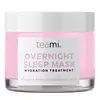What's inside
What's inside
 Key Ingredients
Key Ingredients

 Benefits
Benefits

 Concerns
Concerns

 Ingredients Side-by-side
Ingredients Side-by-side

Aloe Barbadensis Leaf Juice
Skin ConditioningGlycerin
HumectantNeopentyl Glycol Diheptanoate
EmollientIsododecane
EmollientBrassica Oleracea Italica Seed Oil
EmollientNiacinamide
SmoothingPelargonium Graveolens Oil
MaskingPyrus Malus Fruit Extract
Skin ConditioningSodium Hyaluronate
HumectantDaucus Carota Sativa Seed Oil
EmollientTocopheryl Acetate
AntioxidantUbiquinone
AntioxidantVaccinium Myrtillus Fruit/Leaf Extract
AstringentDodecylxylylditrimonium Chloride
Ascorbic Acid
AntioxidantFerulic Acid
AntimicrobialButyrospermum Parkii Nut Extract
EmollientSqualane
EmollientClitoria Ternatea Fruit Extract
Skin ConditioningMica
Cosmetic ColorantEnteromorpha Compressa Extract
Skin ProtectingCurcuma Longa Root
Skin ConditioningQuercetin
AntioxidantCamellia Sinensis Leaf Extract
AntimicrobialEthylhexylglycerin
Skin ConditioningAloe Barbadensis Leaf Juice, Glycerin, Neopentyl Glycol Diheptanoate, Isododecane, Brassica Oleracea Italica Seed Oil, Niacinamide, Pelargonium Graveolens Oil, Pyrus Malus Fruit Extract, Sodium Hyaluronate, Daucus Carota Sativa Seed Oil, Tocopheryl Acetate, Ubiquinone, Vaccinium Myrtillus Fruit/Leaf Extract, Dodecylxylylditrimonium Chloride, Ascorbic Acid, Ferulic Acid, Butyrospermum Parkii Nut Extract, Squalane, Clitoria Ternatea Fruit Extract, Mica, Enteromorpha Compressa Extract, Curcuma Longa Root, Quercetin, Camellia Sinensis Leaf Extract, Ethylhexylglycerin
Oryza Sativa Extract
AbsorbentButylene Glycol
HumectantGlycerin
HumectantHelianthus Annuus Seed Oil
EmollientBetaine
HumectantNiacinamide
SmoothingDimethicone
Emollient1,2-Hexanediol
Skin ConditioningCetearyl Olivate
Sorbitan Olivate
EmulsifyingElaeis Guineensis Oil
EmollientElaeis Guineensis Kernel Oil
EmollientHydroxyethyl Acrylate/Sodium Acryloyldimethyl Taurate Copolymer
Emulsion StabilisingCetearyl Alcohol
EmollientEthylhexylglycerin
Skin ConditioningArginine
MaskingCarbomer
Emulsion StabilisingAllantoin
Skin ConditioningXanthan Gum
EmulsifyingOryza Sativa Extract, Butylene Glycol, Glycerin, Helianthus Annuus Seed Oil, Betaine, Niacinamide, Dimethicone, 1,2-Hexanediol, Cetearyl Olivate, Sorbitan Olivate, Elaeis Guineensis Oil, Elaeis Guineensis Kernel Oil, Hydroxyethyl Acrylate/Sodium Acryloyldimethyl Taurate Copolymer, Cetearyl Alcohol, Ethylhexylglycerin, Arginine, Carbomer, Allantoin, Xanthan Gum
 Reviews
Reviews

Alternatives
Ingredients Explained
These ingredients are found in both products.
Ingredients higher up in an ingredient list are typically present in a larger amount.
Ethylhexylglycerin (we can't pronounce this either) is commonly used as a preservative and skin softener. It is derived from glyceryl.
You might see Ethylhexylglycerin often paired with other preservatives such as phenoxyethanol. Ethylhexylglycerin has been found to increase the effectiveness of these other preservatives.
Glycerin is already naturally found in your skin. It helps moisturize and protect your skin.
A study from 2016 found glycerin to be more effective as a humectant than AHAs and hyaluronic acid.
As a humectant, it helps the skin stay hydrated by pulling moisture to your skin. The low molecular weight of glycerin allows it to pull moisture into the deeper layers of your skin.
Hydrated skin improves your skin barrier; Your skin barrier helps protect against irritants and bacteria.
Glycerin has also been found to have antimicrobial and antiviral properties. Due to these properties, glycerin is often used in wound and burn treatments.
In cosmetics, glycerin is usually derived from plants such as soybean or palm. However, it can also be sourced from animals, such as tallow or animal fat.
This ingredient is organic, colorless, odorless, and non-toxic.
Glycerin is the name for this ingredient in American English. British English uses Glycerol/Glycerine.
Learn more about GlycerinNiacinamide is a multitasking form of vitamin B3 that strengthens the skin barrier, reduces pores and dark spots, regulates oil, and improves signs of aging.
And the best part? It's gentle and well-tolerated by most skin types, including sensitive and reactive skin.
You might have heard of "niacin flush", or the reddening of skin that causes itchiness. Niacinamide has not been found to cause this.
In very rare cases, some individuals may not be able to tolerate niacinamide at all or experience an allergic reaction to it.
If you are experiencing flaking, irritation, and dryness with this ingredient, be sure to double check all your products as this ingredient can be found in all categories of skincare.
When incorporating niacinamide into your routine, look out for concentration amounts. Typically, 5% niacinamide provides benefits such as fading dark spots. However, if you have sensitive skin, it is better to begin with a smaller concentration.
When you apply niacinamide to your skin, your body converts it into nicotinamide adenine dinucleotide (NAD). NAD is an essential coenzyme that is already found in your cells as "fuel" and powers countless biological processes.
In your skin, NAD helps repair cell damage, produce new healthy cells, support collagen production, strengthen the skin barrier, and fight environmental stressors (like UV and pollution).
Our natural NAD levels start to decline with age, leading to slower skin repair, visible aging, and a weaker skin barrier. By providing your skin niacinamide, you're recharging your skin's NAD levels. This leads to stronger, healthier, and younger looking skin.
Another name for vitamin B3 is nicotinamide. This vitamin is water-soluble and our bodies don't store it. We obtain Vitamin B3 from either food or skincare. Meat, fish, wheat, yeast, and leafy greens contain vitamin B3.
The type of niacinamide used in skincare is synthetically created.
Learn more about Niacinamide